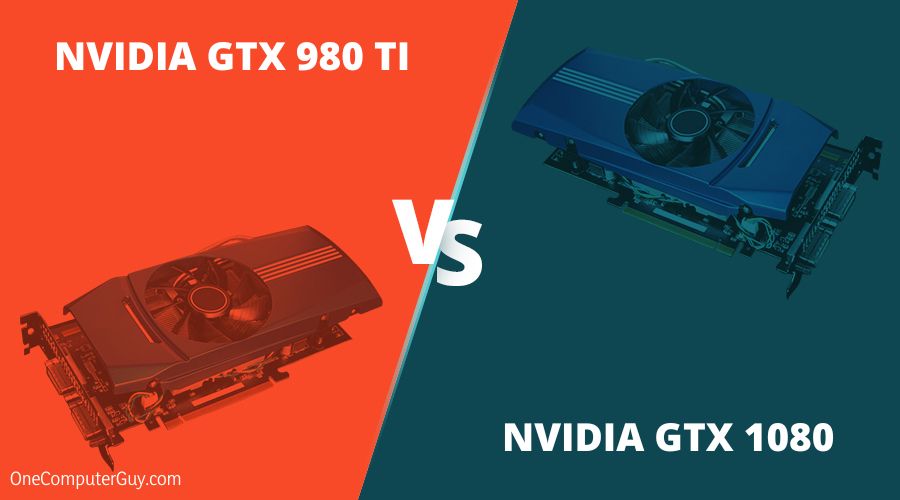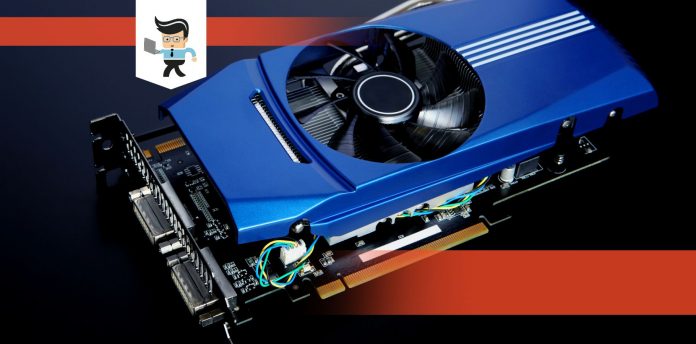The GTX 980 TI vs GTX 1080 is a competition where, if the simple framerates were the only factors to be considered, there would be a clear winner. However, because the 980 TI is significantly less expensive, it provides a better value for the money and the sacrifices in performance are not as large as you might expect.
 Both cards will run modern games well on high quality graphics settings, and they will also run virtual reality games. So, consider the facts to answer the question: is the 980 TI or the 1080 the card for you?
Both cards will run modern games well on high quality graphics settings, and they will also run virtual reality games. So, consider the facts to answer the question: is the 980 TI or the 1080 the card for you?
| Key Specifications | |
| GTX 980 TI |
|
| GTX 1080 |
|
Contents
1. NVIDIA GTX 980 TI
- Maxwell architecture, older, 28 nm silicon
- Lower clock speeds than 1080
- Slower and less memory
980 TI Specs:
| GTX 980 TI | |
| CUDA cores | 2816 |
| ROPs | 96 |
| Base Clock | 1000 MHz |
| Boost Clock | 1075 MHz |
| Length | 267 mm |
| Float Performance | 5632 GFLOPS |
| GPU | 6 GB GDDR5 |
| Max TDP | 250 W |
| Architecture | Maxwell |
Taking a look at GTX 980 Ti from a specifications perspective, at its launch the card was unique placed, positioned between the 980 and the 1080, but sharing the same board as the contemporary card of its time, the Titan X, with a few notable restrictions including a reduction in the chips. NVIDIA disabled 2 of GM200’s 24 SMMs from the Titan X, bringing it down to 22 SMMs for a total of 2816 active CUDA cores. The second change was to dial back the amount of VRAM, from GTX Titan X’s 12GB to the 6GB we see on GTX 980 Ti. And that’s it.
In every other aspect the GTX 980 Ti is identical to the GTX Titan X, both have a base clock out of the box of 1000MHz, with a boost clock of 1075MHz. Both are power hungry with a total power consumption of 250 Watts, and are equipped with NVIDIA’s metal-shrouded cooler . Lastly, the GTX 980 Ti retains enough of the same architecture of the Titan X that it competes easily with the Titan in pixel-heavy situations like 4K.
It’s no wonder that when the GTX 1080 specifications were announced, it was hyped to outpace the Titan X, because it was designed to be an upgrade to the 980 TI, and the 980 TI was using the same basic hardware as the Titan X.
The GTX 980 TI was a deceptive card when it came out because people expected it to underperform, but it held its own against both NVIDIA’s flagship models of its time as well as the direct competitors in the AMD market. Even years later it still holds up well to user benchmark tests, delivering blistering framerates in popular games, even visually demanding ones.
According to User Benchmark, it topped 80 frames per second for PUBG and Grand Theft Auto: V, achieved well over 100 frames per second for Overwatch and Counter-Strike: Global Offensive, and even cleared 200 frames per second for Minecraft and League of Legends. Analysis of data submitted by users, the 980 TI still performs well.
At the time of their respective launches, the 980 TI cost a little more than 1080, and at the same time, predictably, the earlier model cards dropped in price. When the 980 TI debuted, the cost of the 980 fell so that it would not compete in the same price point as the 980 TI, while the 6 GB difference in memory did little to justify the fact that the Titan X was almost half again as expensive as the 980 TI.
– Power
The GTX 980 TI power requirement compared to 1080 leaves something to be desired. The 980 TI has the potential to draw a total of 250 Watts from the system, which is far above and beyond the 180 W TDP limit of the GTX 1080. This is a vestige of the fact that the GTX 980 TI uses the same board and technology of the Titan X, which was over-engineered as NVIDIA’s flagship model.
– Physical Size
In terms of size, the GTX 980 TI length is comparable to other graphics cards by both NVIDIA and AMD. It occupies 267 mm inside the case, the same size as the GTX 1080, and the card will take up two PCIe slots at the back of the computer when plugged into the motherboard.

This means that you need to make sure that your case is deep enough to accommodate the 11” length and that you don’t need to plug anything into the PCIe lane directly beside the slot of the motherboard where you are putting your 980 TI.
2. NVIDIA GTX 1080
- Pascal architecture, newer 16 nm silicon and first card following die shrink
- Higher clock speed
- Faster, larger memory
GTX 1080 Specifications:
| GTX 1080 | |
| CUDA cores | 2560 |
| ROPs | 64 |
| Base Clock | 1607 MHz |
| Boost Clock | 1733 MHz |
| Length | 267 mm |
| Float Performance | 8228 GFLOPS |
| GPU | 8 GB GDDR5 |
| Max TDP | 180 W |
| Architecture | Pascal |
Nvidia’s GTX 1080 employs the new Pascal architecture, and when it was being hyped prior to release, boasted features targeted toward improving the virtual reality experience on PC. It also brought a new level of rendering performance too, but one of the most startling claims was that the new GTX 1080 was that it would outpace the standing flagship card, the Maxwell-based Titan-X, in terms of raw performance and doubling it in certain virtual reality applications.
The NVIDIA GTX 1080 flagship card was, at its release, the first in their “Pascal” line which employed the newest 16 nanometer silicon architecture, a distinct improvement over the 28 nanometer architecture of the Maxwell line. The 16nm fabrication scale means the GTX 1080 boasts over 7 billion transistors. The GTX 1080 has a base clock of 1607MHz and boosts up to 1733MHz under load. The NVIDIA GTX 1080 comes with 8 GB of GDDR5X VRAM as opposed to the 6 GB on the GTX 980 TI.
For standard gaming, the GTX 1080 easily handled the stunning visuals and technically demanding workload of a maximized graphics settings and high resolution Grand Theft Auto V. To provide a side-by side comparison with another game, and to test Pascal’s DirectX 12 capabilities, Rise of the Tomb Raider puts but the GTX 1080 and the 980 TI through their paces. Both titles come with integrated benchmarks to test their specifications.
The NVIDIA GTX 1080 was the direct replacement for the existing NVIDIA GTX 980, but the GTX 980 TI is the card in the middle between them, a step up from the 980 technology that still runs on the older Maxwell architecture. The step from the 980 TI to the 1080 introduces significantly more computing power which allows for a smoother, higher quality, and higher resolution gaming experience.
– Power
The power for the 1080 is considerably less aggressive than it could be, especially in comparison to the 980 TI. The 980 TI has the potential for a TDP (the total power consumed by the system) of 250 Watts, which is far above and beyond the 180 W TDP limit of the GTX 1080.
– Physical Size
The GTX 1080 is 267 mm or 11” long, which is a fairly standard size for a graphics card. If you have been using an old computer and there is not a lot of space, you should check to make sure that your case can accommodate the graphics card. Like the 980 TI, the card will take up two PCIe slots at the back of the computer.
This means that you need to make sure you don’t need to plug anything into the PCIe lane directly beside the slot of the motherboard where you are putting your 1080 because it will not fit.
NVIDIA GTX 980 TI and 1080 Benchmarks
The main difference between 980 TI and 1080 is, GTX 1080 provides a clear increase in performance, a resolution option that tops 30 frames per second and a higher passmark score compared to GTX 980 TI.
– Grand Theft Auto
In the spirit of pushing these highly capable cards, and in recognition of their price tags, maxing out settings for the games was the only option to get a true accounting of how the cards would perform under pressure.
Rockstar pulled out all the stops in creating the visuals for the PC iteration of Grand Theft Auto: V and the higher the resolution, the more impressive the game looks. Even with no anti aliasing, Grand Theft Auto: V is a feast for the eyes, and both cards deliver excellent frame rates. The GTX 1080 comes out ahead due to its ability to provide a clear increase in performance compared to the 980 Ti, delivering a comfortable, although not explosive 19% lead over the older card.
NVIDIA’s DSR (Dynamic Super Resolution) technique can be used to great effect in punishing the cards for testing because it will render the game at twice the native resolution of the test monitor. When it comes time to display the image, it will down sample and then deliver the imagery to the monitor.
So what exactly is the point of all this? Super sampling the images with this feature gives you the option to deliver uncompromising image quality and sharpness, cutting out the jagged edges and corners to produce an all-round richer image. This is, effectively, extreme antialiasing in effect, though it is done in an atypical manner.
The 980 Ti puts up a decent fight with Grand Theft Auto delivering average framerates hovering in the low twenties of frames per second, but the GTX 1080 manages a (very nearly) playable 27FPS on maximized settings.
Hovering in the high twenties, the GTX 1080 is close to the generally accepted minimum threshold for games of 30 frames per second. With overclocking, the GTX 1080 can cross over the threshold into playability, giving gamers a pretty astounding resolution option that tops 30 frames per second.
– Rise of the Tomb Raider
DirectX 12 is the future as far as Windows gaming is concerned, and games with DX 12 support are now filtering through finally. Rise of the Tomb Raider is a particularly gorgeous (and demanding) example of a game with DX 12.
Every setting is set to its highest available, once again no anti-aliasing was applied with the settings in the game. Hot off the starting line, the new GTX 1080 demonstrates its prowess in DX12 with an impressive 50% gain over its predecessor and without any antialiasing applied. Running the game at a high resolution and aspect ratio with every setting maxed is a real visual treat. With 1080 delivering an eminently playable 67 FPS, the game not only looks pretty, but it plays incredibly well too.
By changing things up and switching Rise of the Tomb Raider over to the DirectX 11 renderer puts the 980 Ti on more a more comfortable footing to compete with its younger, fitter brother. It looks like it can close the gap on GTX 1080, but even with the less demanding rendering, the GTX 1080, Pascal-based card still manages to command a solid 25% lead. 69 FPS vs 53 frames per second.
Finally, utilizing 2 x SMAA in DX11 highlights the fact that 1080 has room to spare when it comes to performance, as it pushed an average 44 frames per second, 33% more than the GTX 980 Ti.
– Virtual Reality Capability
If you try to apply 2D gaming benchmarking methods and testing standards to virtual reality you’ll find yourself running up against a brick wall. Due to the nature of virtual reality and the mechanics involved, the desktop consumer VR systems may use of some clever rendering tricks when delivering imagery to present a consistent display update.
In the case of the Oculus Rift the most problematic issue with the headset is something called an Asynchronous Time Warp. This is a technology that was invented to help virtual reality situations when the player is making movements to control the character. Asynchronous Time Warp’s primary function in virtual reality is to smooth over any flaws in the rendering performance (though it doesn’t always work).
Ideally what the feature of Asynchronous Time Warp will do by smoothing the lumps and jitters in the render is to reduce the chance of the games resulting in nausea as a response by the users. It does this by drawing any given frame when delivering it for display only after taking into account and using the most up to date position of the user’s head, and making sure that the final image will match.
This causes a problem for existing benchmark measurements with VR. When you try and apply regular logic to the tests, it fails because the virtual reality is designed in a specific way.
Even if your GPU pegs the benchmark and seems to be falling behind the standard in presenting sequential frames, the user may not experience any negative effect from the missing frames.
When the user is playing a game in virtual or augmented reality, they are constantly being presented with the view that their brain is expecting, relative to their head’s movement.
Essentially what this means is that any drops in frames, which will be picked up by the benchmarking metrics gathering software, may not result in a true cause for concern. The user may not even be able to see if there is anything wrong because the frames will be where they are supposed to be.
The dropped frames as a result of Asynchronous Time Warp will register as dropped frames regardless of the fact that they needed to be dropped to complete the necessary visual presentation and result in an artificitally low benchmark.
Additionally, good VR applications are designed and built from the ground up to prioritize frame rate over visual fidelity. Not everyone can afford to build a top of the line computer, but more and more people want to take part in the virtual reality sensation.
By building a stable VR technology, one of the key features of the virtual reality gaming industry is to make sure that those on the lowest recommended hardware will still receive a smooth, nausea-free experience.
That focus on stability of frame rate has served as an excellent jumping-off point for the rest of the game design. It also meant that developers do not want to include page after page of graphics options and settings PC users are accustomed too – the last thing you need as a developer is another set of variables to test when the results may end up in people being sick.
The upshot of the assurance that even low standard virtual reality systems will provide a good experience. The significance of this is that both the GTX 980 Ti and GTX 1080 are extraordinarily overqualified in terms of raw computing power to handle the majority of VR experiences on the market.
– Passmark
The GTX 980 Ti passmark comes in behind the GTX 1080 by a score of one hundred points. The GTX 1080 benchmarks higher than the 980 TI, but it was not deemed to be the best value for the money of the top graphics cards listed on Passmark.
To determine the value based on the Passmark system, the total graphics card score for each card (12451 for the GTX 1080 compared to 980 TI at 11445) is divided by the price to get a number, and the higher that number is, the better, because it means that the performance is higher relative to the total cost.

The NVIDIA graphic card comparison in value is clear: GTX 980 TI comes in at a Passmark score to price ratio of 23.48 while the GTX 1080 has a ratio of 18.58. The GTX 1080 has the 980 TI beat in terms of raw performance, but the value for money belongs to the 980 TI.
Conclusion
The GTX 1080 at the time of its release was the most powerful card produced by NVIDIA. Raw rendering performance gains over the established Maxwell-based GTX 980Ti, though not earth shattering, are significant – especially when using DirectX 12 benchmarks. In 2D applications the card can push high resolution gaming to large screen sizes, and when it comes to VR gaming, it provides the opportunity for high quality options that are perhaps just out of reach of the 980Ti’s capabilities to render.
The new Pascal 16nm GPU provides excellent efficiency, though only when limited to load temperatures of around 55-65 degrees centigrade or less.
The increased efficiency over the Maxwell line made the 1080 a prime option for overclockers and people who wanted to squeeze as much performance out of their graphics cards as possible.
The 980 TI comes within close striking distance of the 1080, but in terms of raw performance numbers, the 1080 is the definitive winner. However, if all you need is a good card to play the games you want at decent framerates and you don’t mind sacrificing a little in terms of speed and graphics settings, then you can pick up a 980 TI which is still a good card and save yourself some money by getting a slightly older card which is still a good piece of technology.







